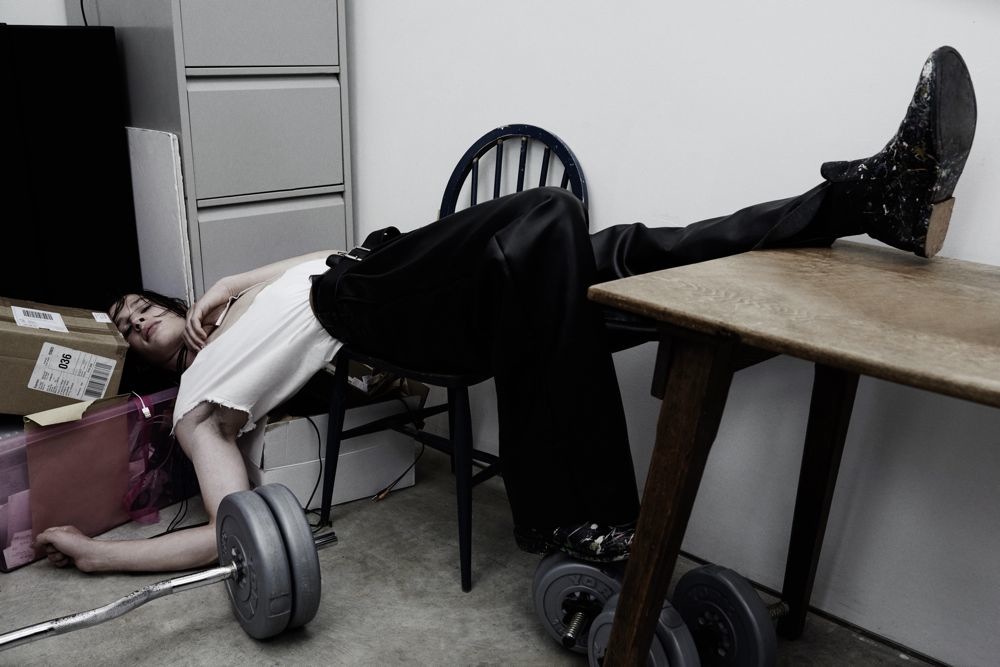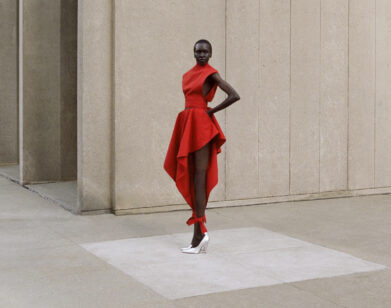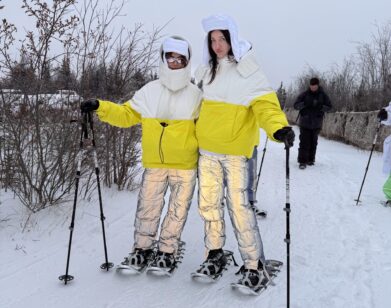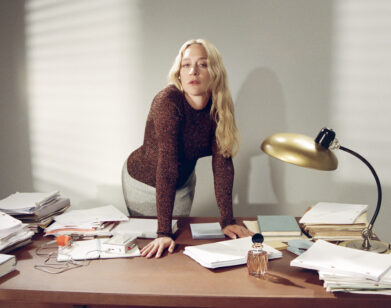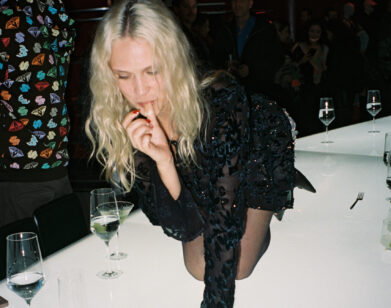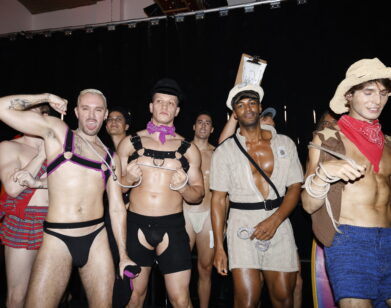The Menswear Designer
PHOTOS: RAF STAHELIN. STYLING: VICTORIA SEKRIER. GROOMING: DANIEL MARTIN/D AND V MANAGEMENT. MODEL: LIAM GARDNER/ SELECT MODEL MANAGEMENT.
For Spring/Summer 2016, Fashion East invited two young designers to show their menswear collections: Grace Wales Bonner and Charles Jeffrey. It’s no small honor, as the London-based non-profit has helped launched the careers of Gareth Pugh, Marques’Almeida, Meadham Kirchhoff, Simone Rocha, and J.W. Anderson, among many others. Jeffrey, however, was hesitant. He’d just finished his B.A. and M.A. at Central Saint Martins, and hosted a successful monthly club night called Loverboy. “I actually didn’t want to do my own label,” he confesses. “I had done this party and I was going to take that forward and maybe do products that were associated with that—denim and maybe some t-shirts,” the 25-year-old Scotland native continues. “I wasn’t interested in doing my own thing because of the money.”
But Jeffrey agreed to present his collection, which mixes London’s clubland aesthetic (paint-splattered cropped trousers held up by a rope belt, shredded shirts) with something more wearable (a boxy pin-stripe jacket, a letterbox-red coat), at the Fashion East show, and Charles Jeffrey the London fashion house was born.
When we speak with the young designer over the phone, he is in the middle of making dinner with a friend. “We’re prepping some sort of intricate chicken thing, but we’re not too sure what we’re doing,” he says. “We’re thinking of making a spinach-y, butter-y chicken with roast potatoes. That’s the vibe.”
AGE: 25
HOMETOWN: Hamilton, South Lanarkshire, Scotland. It’s a mini city in between Glasgow and Edinburgh.
ALMAMATER: Central Saint Martins, London. I started seeing a pattern in people who went there—Gareth Pugh, obviously, John Galliano, Christopher Kane, McQueen—so that’s where I applied.
GROWING UP…I moved around a lot because my dad was in the army. I lived in Germany for a little bit. From Germany, I went to Surrey, outside of London, and from there to this place called Brecken in Wales. When my mum and dad divorced we moved back up to Scotland and stayed in this place called Cumbernauld. Mum and Dad divorced when I was 10. I stayed in Scotland for eight years and then I moved to London when I was 18. But I like to say I’m from Hamilton because that’s where my grandparents have lived the whole time.
FASHION BEGINNINGS: [I first became interested in fashion] at maybe 13 or 14. I think it was more of an identity thing. I was always interested in clothes. My mum was quite into fashion. I would buy magazines sometimes—I remember buying Arena Homme. When I wanted to get into design, it came a little bit later, when I was 16, 17. I started being really interested in London and Gareth Pugh and that whole club scene—Ponystep and BoomBox and stuff.
WOMENSWEAR VS. MENSWEAR: I remember doing little sketches and it was always womenswear. When I was doing my foundation [year], the best course to get onto from the foundation was B.A. Womenswear. That was the main goal. I started being interested in men’s fashion purely as a kind of image thing. It was only in the latter part of my B.A. that I started realizing that menswear was probably the best place for me to go to. I think it was the time; there was a focus on menswear around the time I was doing my final year. There were lots of designers that were coming out like Craig Green, Christopher Shannon. Menswear week was happening separately to fashion week. It also felt right because all of my womenswear came from a weird place, whereas menswear was based more on my own personal wardrobe. It felt more honest.
CHARLES JEFFREY VS. THE CHARLES JEFFREY MAN: On my M.A. I kind of amalgamated both [my personal style and the Charles Jeffrey style]. I always did abstract drawings as a starting point. That was quite encouraged on the B.A. because it was quite loud and expressive, and on the B.A. you’re told to scream this is who you are. In the M.A., they’re more interested in a process and it being something that’s cool and coming from somewhere that feels genuine. When I was working with Louise [Wilson, the former director of Central Saint Martins’ M.A. program], she would kind of diss my drawings—or not diss, but be like, “This isn’t a good viewpoint of menswear. How you have your belt and how you have your trousers, that precise length, is a lot more relevant and interesting for menswear than your weird collages that make no sense to me.” It was only when I started recording my own outfits and how I wear things that it started coming together. After Louise died and Fabio [Piras] took over, Fabio started saying that as well. I would come in in an outfit, and Fabio would be like, “Why have we not got this pair of trousers in the collection?” It was interesting to see how two people from two different viewpoints said the same thing.
FROM JAMES LONG TO JACK WILLS TO CHRISTIAN DIOR: When I was in the B.A., we had an internship year. I interned for two really weird companies—well, three. I interned for James Long for a wee while. Then I interned for this commercial company called Jack Wills. I worked in the store when I was in my first and second year, and it was a really well paid placement, whereas a lot of placements don’t pay at all. The biggest placement I got was Christian Dior in Paris. When I got that placement I was a bit scared: “I don’t know how I’m going to afford to do that when I’ve got a job on the side, because I can’t really work in Paris and do this internship.” My boss at the times at Jack Wills was like, “Why don’t you do this internship at Jack Wills?” Christian Dior was obviously amazing. You got to see the top of the top —the old ateliers and the couturiers work their magic. Then working at Jack Wills, I got to see how a commercial company worked. It was quite interesting to see those two sides of the spectrum. At Jack Wills, I kind of adopted this role of researcher. Their starting point of research came from English culture and Oxbridge, and I would do research on the cricketing jumpers that were worn in the 1930s and we got to see these jumpers in real life and they were really beautiful.
FASHION EAST: Then Fashion East came to the [Central Saint Martins] show. I remember my sister telling me—because she was sitting behind Lulu Kennedy—that she saw my name was circled a lot in big red pen, so they knew they wanted to see me straight away. They asked me, “Would you be interested in doing this?” I was like, “Oh, I don’t know. I don’t think I should because of the money.” Then I got another email from them again saying, “We’d like to invite you to be part of the presentations. We really think this is something you can do.” I remember speaking with Fabio. We had had really long talks about what I could be doing because the way I design is very different to the way most designers work. I work in quite a chaotic way, so the discussion of working in a fashion house went out of the window. He was like, “I don’t think this is something you can do. You work in this weird way.” Then when they said I could maybe do my presentation, Fabio was like, “Well, maybe you can do this artwork and the party that you’ve been doing and apply it to that.” I guess I got the confidence and the validation [to start my own label] from discussing with Fabio and being given that platform from Fashion East.
Fabio was really patient with how I worked. I would come in with lots of little bits of work and I would do one thing and then jump to something else. But I ended up having a relationship with him where I could just walk in and be like, “This is what I’ve done and this is what I’m doing.” That extended into after graduation. I still go and see him now—he offers advice and stuff.
THE ART OF THE COLLAGE: Collaging, to me, is a really great way to put research together and to suggest something a bit abstract as a design proposal. I recently taught a course last month on how to make a sketchbook at Saint Martins and the students that I had, I was getting them to do collages as a way to bring two aspects of research together. It was quite a basic course. They’d never done anything fashion related before. So it was quite like, “Let’s research historical dress instead of looking at recent fashion. Let’s look at a sculpture or an artist and let’s put these two together.” Then you’d have people who would be looking at Nero and the ’40s, and the we’d do these collages and they’d get something quite interesting—your own personal take on proportion and what you’re wanting and shape. I still find it a really useful way to put research together. Also for my illustrations, working with lots of different media and collaging that together. I find I make something that’s a lot more interesting than perhaps just doing a particular drawing on its own with one medium.
NEXT UP… I’ve got a few projects lined up. I’m doing a project with ShowStudio for Paris Fashion Week, which is an illustration project. Then I’m doing research for next season and trying to do a bit of production for this season. I can’t really afford to do proper production at the moment because I haven’t got the funds. It’s all coming out of my own pocket. I can do a few bits—I can do the denim; I can do some t-shirts. I have to work quite small and I don’t know if that will be accommodated in bigger stores. I am going to be showing as part of the Man show and Fashion East next season, which is sponsored by Topman.
NEW YORK, NEW YORK: After I graduated, Zachary from V-Files, before he moved to Hood by Air, had met me and he had said, “We should do a project, you should do your party out here and do the denim.” That was before I was approached by Fashion East, so my original idea was just to do the party in New York and sell the denim through that. I would love to come to New York. It’s my dream city. I’ve never been before.
FALL/WINTER 2016: I’m working with this film artist, and working in this way that’s sort of about the super-ego, the ego, and the id and how that applies to adulthood. It sounds quite complicated, but I’ll probably boil that down to something more straightforward. It’s about how clothes would operate in those of spectrums. The painted denim and the color kind of operate in the id sense—it’s expressive, it’s kind of childish, it’s uncontrollable. Then there’s that super-ego side—you’re expected to look a certain way as a man, elements of masculinity that are associated with fitting. Then the ego is kind of how they amalgamate together. I’m taking different aspects of the collections I’ve done before and evolving them in this setting. That’s the general concept.
FOR MORE ON CHARLES JEFFREY, VISIT HIS WEBSITE.
For more from our 16 Faces of 2016, click here

